Pennsylvania is home to hundreds of spider species. That is too many to list here, which is why we have put a list together of the 60 most common spiders you can identify in Pennsylvania, from the most popular to the least popular.
The 60 common spiders you may come across in Pennsylvania include:
Table of Contents
1. Orchard Orbweaver
Scientific name: Leucauge venusta.
Common name: orchard spider.
The orchard orbweaver is found in numerous states in the United States with females being larger than the male, growing to around 7.4cm. Males grow to around 4cm.

They are very colorful spiders with a green to yellow carapace with brown to black on the sides and a silver abdomen with dark stripes.
The belly can be red, silver, yellow, blue, or green and is marked with a yellow, red, or orange crescent and green legs.
2. Bold Jumping Spider

Scientific name: Phidippus audax.
Common name: daring jumping spider, bold jumping spider.
The bold jumping spider is able to jump four times its body length with rapid-fire pouncing when it ambushes prey, this also helps the spider escape predators.
They are not easy to catch and it’s very unlikely that they will bite a human. If they do bite, their venom is not dangerous and may cause a slight stinging sensation.
These black spiders have a white line that runs over the abdomen with two white dots close to the back.
They live in just about any habitat, including cars and homes.
They do not spin webs and are active hunters during the day.
Further Reading:
3. Yellow Garden Spider

Scientific name: Argiope aurantia.
Common name: yellow garden spider, black and yellow garden spider, golden garden spider, writing spider, zigzag spider, zipper spider, corn spider, banana spider, Steeler spider, McKinley spider.
The yellow garden spider has an egg-shaped abdomen with yellow or orange on black as the base color.
The female can grow to 2.8cm, while males follow at around 9mm.
The front of their bodies is covered in silver hairs with black legs that have red or yellow closer to the body.
Each leg has three claws, one more than other spiders which helps them handle the threads when spinning their web.
Their venomous bite helps them subdue prey, but is not harmful to humans and may cause some mild discomfort.
4. Dark Fishing Spider

Scientific name: Dolomedes tenebrosus.
Common name: dark fishing spider.
The dark fishing spider is very similar to the striped fishing spider. Females grow to an inch in length (2.4cm), while males only grow half that length.
Their legs can be up to 3.5 inches (8.8cm) long.
They are light to dark brown in color with chevron markings and brown to red banding on the legs.
5. Grass Spiders

Scientific name: Genus Agelenopsis.
Common name: American grass spiders, grass spiders.
Grass spiders are very common in the summertime. They create cave-like webs on grassy lawns.
They are exceptionally fast and will catch their prey in a matter of seconds, dragging them back to their web.
The grass spider is often confused with a wolf spider, due to them having a similar color pattern. The difference is the glass spider’s abdomen has mostly chevrons, while the wolf spider has a bold black line running down the center ending in a point.
The glass spider is not venomous and it is very unlikely that it will bite.
6. Tan Jumping Spider

Scientific name: Platycryptus undatus.
Common name: tan jumping spider.
The tan jumping spider is a hunting spider and not a sit and wait predator. They will ambush their prey and are fast runners. They leap towards their prey, while a strand of silk shoots at the target, reducing the risk of the prey escaping.
They hibernate in groups during the winter months.
They are hairy and brown in color and are friendly when you handle them gently. They are not likely to bite but may do so if they are roughly handled.
7. Spined Micrathena

Scientific name: Micrathena gracilis.
Common name: spined micrathena, castleback orbweaver.
The spined micrathena has pointed ridges on its abdomen, making them less appealing to predators. The spines are designed to hurt predators that try and grab them.
They range in brown, white, or black, helping them camouflage in the forest areas. The males do not have sharp ridges and tend to be more white than black in color.
They are active during the day and are mostly observed in forested areas.
8. American Nursery Web Spider

Scientific name: Pisaurina mira.
Common name: American Nursery Web Spider.
The female American nursery web spider is a dedicated mother than carefully carries her egg sac with her fangs and then builds a nursery where the eggs can hatch as she stands guard.
Their webs are spun for their eggs and not for catching prey, they are active hunters that ambush their prey.
Females are tan to light brown with a dark brown streak that runs down the middle of their back. Males have a much lighter colored streak, which can help you identify the male from the female.
9. Marbled Orbweaver

Scientific name: Araneus marmoreus.
Common name: marbled orbweaver, pumpkin spider.
The marbled orbweaver has marbling on the abdomen with an orange head and orange on the upper legs with black and white banding on the lower legs. They are beautiful spiders with some having yellow or orange on their abdomen.
They prefer wooded areas close to water.
Females are double the size of the males and stay hidden and their eggs are orange in color.
These spiders are active in summer and the fall.
If they sense danger they drop to the floor and try and remain hidden until the threat has passed.
They can grow on the larger side but are not aggressive and the risk of them biting you is very unlikely unless provoked.
10. Spotted Orbweaver

Scientific name: Neoscona crucifera.
Common name: Hentz orbweaver, spotted orbweaver, barn spider.
The spotted orbweaver is usually tan, but some are red or orange. Their abdomen markings can also vary from one to the next. Some have clear patterns, while others’ patterns are barely visible. They all have bristle hairs on their head, legs, abdomen, and thorax.
They are usually absorbed between May and August in woodlands, gardens, fields, backyards, and parks.
They are nocturnal and hairy and are seldom seen during the day.
11. Golden Jumping Spider

Scientific name: Paraphidippus aurantius.
Common name: emerald jumping spider, golden jumping spider.
The golden jumping spider is also known as the emerald jumping spider and hunts alone.
It is relatively large for a jumping spider in black with a white stripe on either side of the head and a white border on the top of the abdomen.
They have hairs down the center with white dots and lines on either side of the hairs.
12. Zebra Jumping Spider

Scientific name: Salticus scenicus.
Common name: zebra jumping spider.
Zebra jumping spiders are common in Pennsylvania and they tend to hunt, stalk and leap on prey, jumping up to 10cm, which is fourteen times its body length.
They are often found on rocks, tree trunks, and walls.
They are harmless to humans are curious, seldom biting.
13. Furrow Orbweaver

Scientific name: Larinioides cornutus.
Common name: furrow spider, furrow orb spider, foliate spider.
Female furrow orbweavers can grow to 1.4cm and males to 9mm, their legs can span 3.5cm.
They are identified by their oval and large abdomens with colors ranging from red, grey to black. They almost always have a lighter arrow pointing to the cephalothorax, legs also have a similar arrow pattern.
They prefer moist areas and are usually found near water, where they spin their webs between grass or low shrubs.
They hide during the day and come out at night.
14. Northern Yellow Sac Spider

Scientific name: Cheiracanthium mildei.
Common name: northern yellow sac spider.
Northern yellow sac spiders are encountered often, usually in a home.
They have a dark lance-shaped mark in the middle of their abdomen. Their color ranges from yellow to pale beige with a touch of green. Their fangs and the tips of the legs are dark brown.
They can grow to around a quarter of an inch, males and females are similar in size.
They are nocturnal and seldom seen during the day.
They will bite if provoked, giving a painful bite with venom that can kill the skin tissue. Symptoms include slow healing sores, itching, and swelling.
15. Woodlouse Spider

Scientific name: Dysdera crocata.
Common name: woodlouse hunter, sowbug hunter, sowbug killer, pillbug hunter, slater spider.
Adult female woodlouse spiders can reach 0.59 inches (1.5cm) in length, with males slightly smaller at 0.39 inches (1cm) in length.
They are orange to dark red with a pale yellow to beige abdomen.
They have six eyes.
They are not usually found near humans and therefore they are not often observed.
16. Eastern Parson Spider

Scientific name: Herpyllus ecclesiasticus.
Common name: eastern parson spider.
This medium-sized hairy spider is fast, which helps them catch their prey.
They do not rely on webs to capture prey and are active hunters.
They usually hunt at night. During the day they hide under debris and rocks. They can venture indoors, though they are woodland spiders.
They do not give a venomous bite, but their venom has been known to cause allergic reactions in some people. Bites are usually a result of the spider being trapped in clothing, getting trapped between the skin and clothing.
17. Long-bodied Cellar Spider

Scientific name: Pholcus phalangioides.
Common name: daddy long-legs spider, long-bodied cellar spider, skull spider.
The long-bodied cellar spider has an oval-shaped body and can range in color from gray to brown or even a pale yellow.
Females are larger than the male growing to around 8mm, with males growing to around 6mm in body length. With the front legs, they can be up to 5cm.
They have thin and elongated legs, along with eight eyes which are placed in two spaced groups, three each with two eyes in the middle.
18. Common House Spider

Scientific name: Parasteatoda tepidariorum.
Common name: common house spider, American house spider.
Common house spiders can be found in attics, inside basements, barns, sheds, garages, and more.
Females are often found in close proximity to each other.
These spiders have skinny legs with hairs. They have a bulb of an abdomen which is brown with white and dark patches.
They are small spiders and seldom are a bother to humans. They are not aggressive and often play dead when threatened. If they are handled roughly, they may bite, which can cause discomfort for a couple of days.
19. American Green Crab Spider

Scientific name: Misumessus oblongus.
Common name: American Green Crab Spider.
The American green crab spider is able to walk forwards, backwards, and sideways. They have long front legs, which help them grab their prey.
Most are neon green in color and are small spiders that hide among the petals of flowers.
They are wandering hunters and will search for insects on flowers and plants.
They do not spin websites, though males do spin silk over potential mates.
20. Bronze Jumping Spider
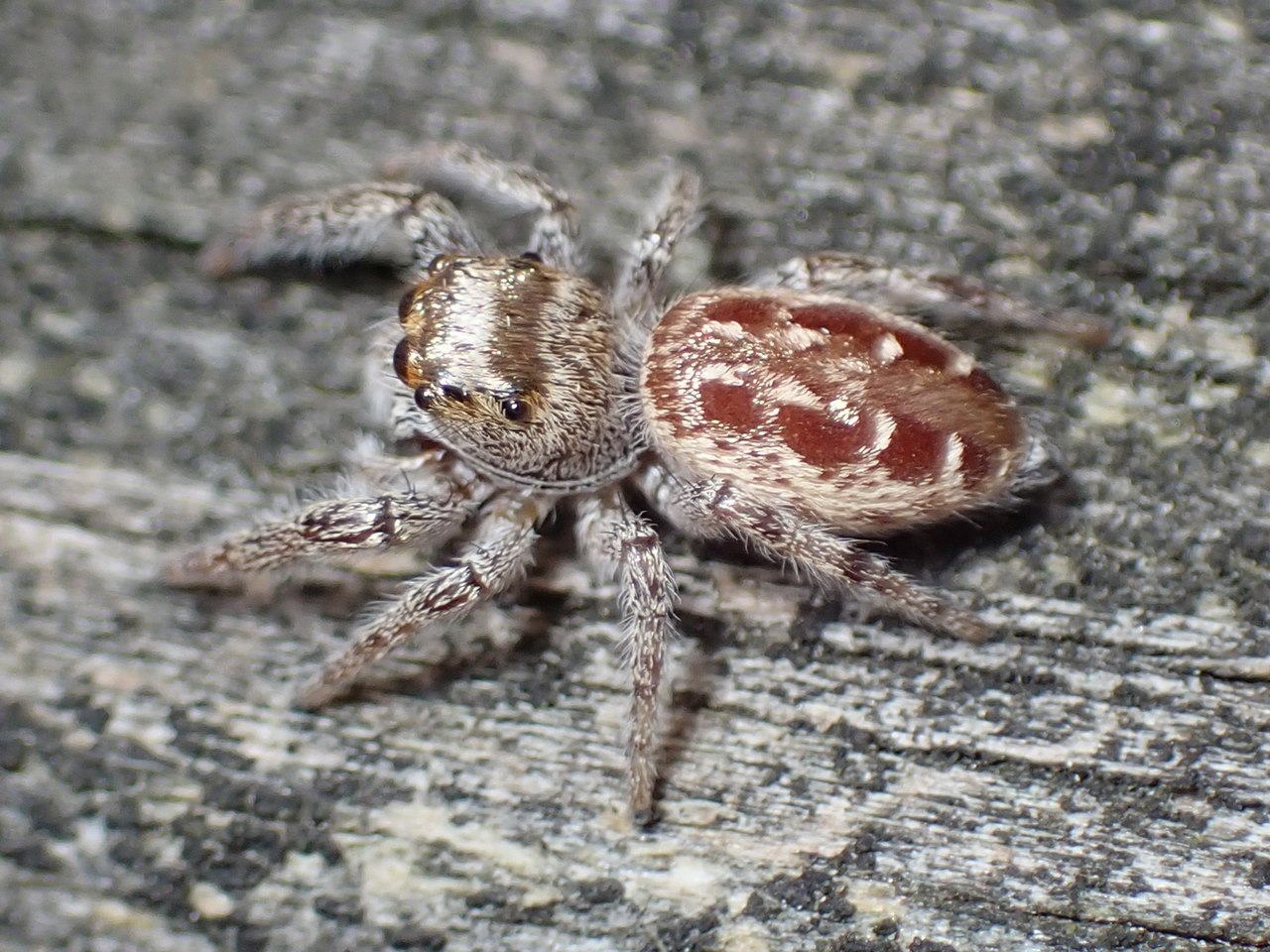
Scientific name: Eris militaris.
Common name: bronze jumper, bronze lake jumper.
Male bronze jumping spiders have white bands on the side of a dark cephalothorax with long chelicerae. Their abdomens tend to be lighter in color with white bands.
Females are lighter than males but have darker abdomens without the white lines.
Females can grow up to 8mm and males up to 6.7mm in body length.
They are not medically significant and will happily jump on your hand. If they do bite, the pain is distracting but disappears very quickly.
21. Asiatic Wall Jumping Spider

Scientific name: Attulus fasciger.
Common name: Asiatic Wall Jumping Spider.
This is a small exotic spider that came from Asia and was introduced to North America in the 1950s.
Females are larger than males.
They have brown abdomens with dark brown and white hairs and two dark brands with white spots at the front and large white spots at the back. Their yellow legs are short with black hairs.
Females look like the male but have a broader abdomen.
Females reach 6mm in body length with males reaching 5mm.
They take up home in buildings, especially those that use artificial light, which attracts insects for easy prey.
22. Banded Garden Spider

Scientific name: Argiope trifasciata.
Common name: banded garden spider, banded orb weaving spider.
The banded garden spider can vary in color from black and white with yellow bands to red or brown with white bands. They darken with age. Their legs are banded in the colors of the abdomen and head.
Males are smaller than females and are often found hanging around the bottom of a female’s web just before mating season.
23. Triangulate Combfoot

Scientific name: Steatoda triangulosa.
Common name: triangulate cobweb spider, triangulate bud spider, triangulate combfoot.
The triangulate combfoot has a distinctive triangular pattern on the abdomen.
They are common in homes where they hide in dark corners and in out buildings.
They are small in size and not dangerous to humans with venom that is not life-threatening.
24. Arrow-shaped Orbweaver

Scientific name: Micrathena sagittata.
Common name: arrow-shaped micrathena.
The arrow-shaped orbweaver has an arrow-shaped abdomen, as the name suggests.
Females have sharp spines that protrude from the abdomen, warding off predators. Males are mostly black in color and lack the sharp spines. Females are often red with a bright yellow arrow shape on their abdomen with some red spots.
Females are double the size of the males, they both prefer outdoor habitats and are often observed in forests.
25. Flea Jumping Spider

Scientific name: Naphrys pulex.
Common name: Flea Jumping Spider.
Flea jumping spiders belong to the Salticidae family and have excellent vision and are skilled jumpers and intelligent hunters.
Males tend to be grey with black mottling and orange on the sides of the cephalothorax.
They are found in wooded areas and tall grass.
26. Cross Orbweaver

Scientific name: Araneus diadematus.
Common name: European garden spider, diadem spider, orangie, cross spider, crowned orb weaver, pumpkin spider.
The cross orbweaver has white cross markings on a dark brown abdomen.
They originally came from Europe and were transported to North America, where they have settled into a range of habitats.
They are not harmful to humans and are welcomed in gardens for keeping pests away that destroy plants.
Females are almost double the size of the male with both genders being dark brown with short hairs on their legs and tan bands.
The abdomen cross is a number of dots and dashes.
Their preferred habitat is woodlands, meadows, gardens, evergreen forests, and semi-arid deserts.
27. Arrowhead Orbweaver

Scientific name: Verrucosa arenata.
Common name: triangle orb weaver, arrowhead spider, arrowhead orbweaver.
The arrowhead orbweaver is easy to identify with its bulbous abdomen with the tip shaped like an arrow.
It has a yellow to white triangle on the top of the abdomen, helping identify it quickly. The body is usually red-brown, though shades do vary.
They spin their webs in shady areas, sitting in their webs with their heads up.
28. Basilica Orbweaver

Scientific name: Mecynogea lemniscata.
Common name: basilica orbweaver.
The basilica orbweaver is a beautiful spider with unique colors, patterns, and shapes.
Their long abdomen is usually yellow, green, or orange and is a bulging rectangular shape. The sides are green with white dots and the dorsal side is white-edged with orange lines and bright yellow, black and brown inlays.
Their legs are thin and green with brown feet and spiky hairs.
Their carapace looks like a cat’s eye with a line running down the center.
29. Wetland Giant Wolf Spider
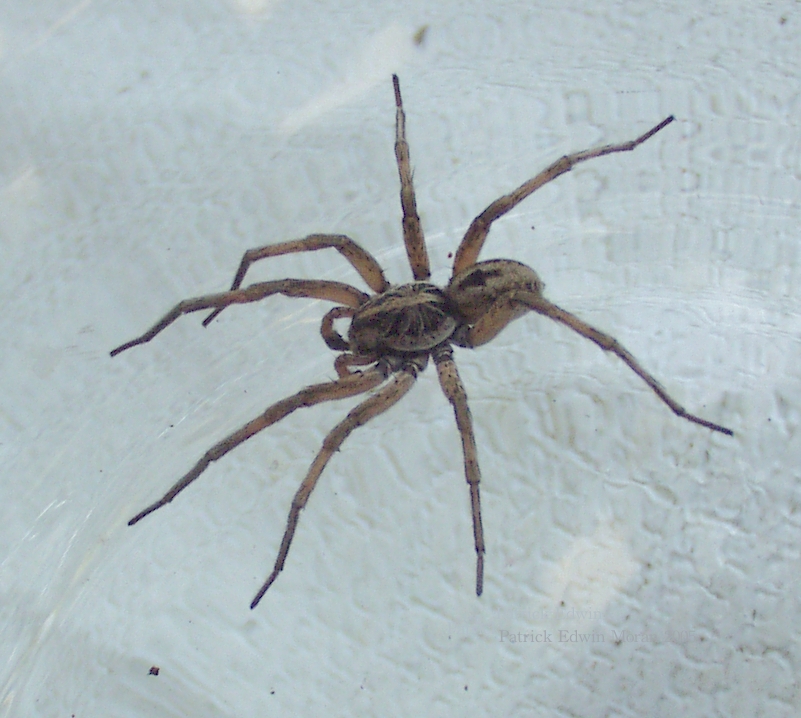
Scientific name: Tigrosa helluo.
Common name: Wetland giant wolf spider.
The wetland giant wolf spiders are a member of the Lycosidae family and can be found in Pennsylvania with females growing to around 3.4cm and males being slightly smaller at 2.4cm.
They are not aggressive and will not bite unless they do not have another choice.
They do inject venom, but it causes minor discomfort to humans and is not considered medically significant. Bites can cause swelling and pain, which disappear on their own within 48 hours.
30. Striped Fishing Spider
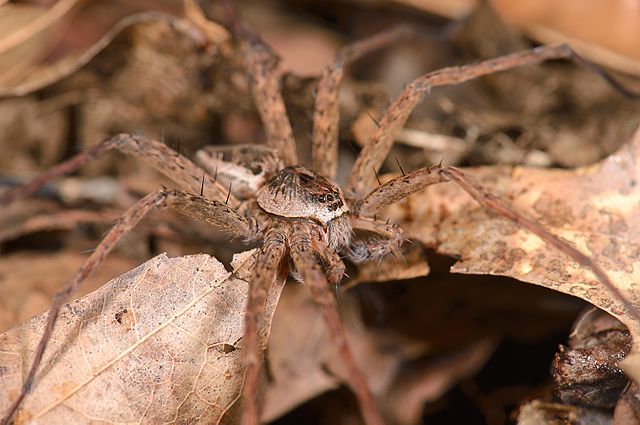
Scientific name: Dolomedes scriptus.
Common name: striped fishing spider.
The striped fishing spider can be found throughout the United States and Canada.
Females can grow up to 6cm, including their legs.
They are pale brown with light stripes around the legs and a stripe down either side of the body.
31. White-jawed Jumping Spider
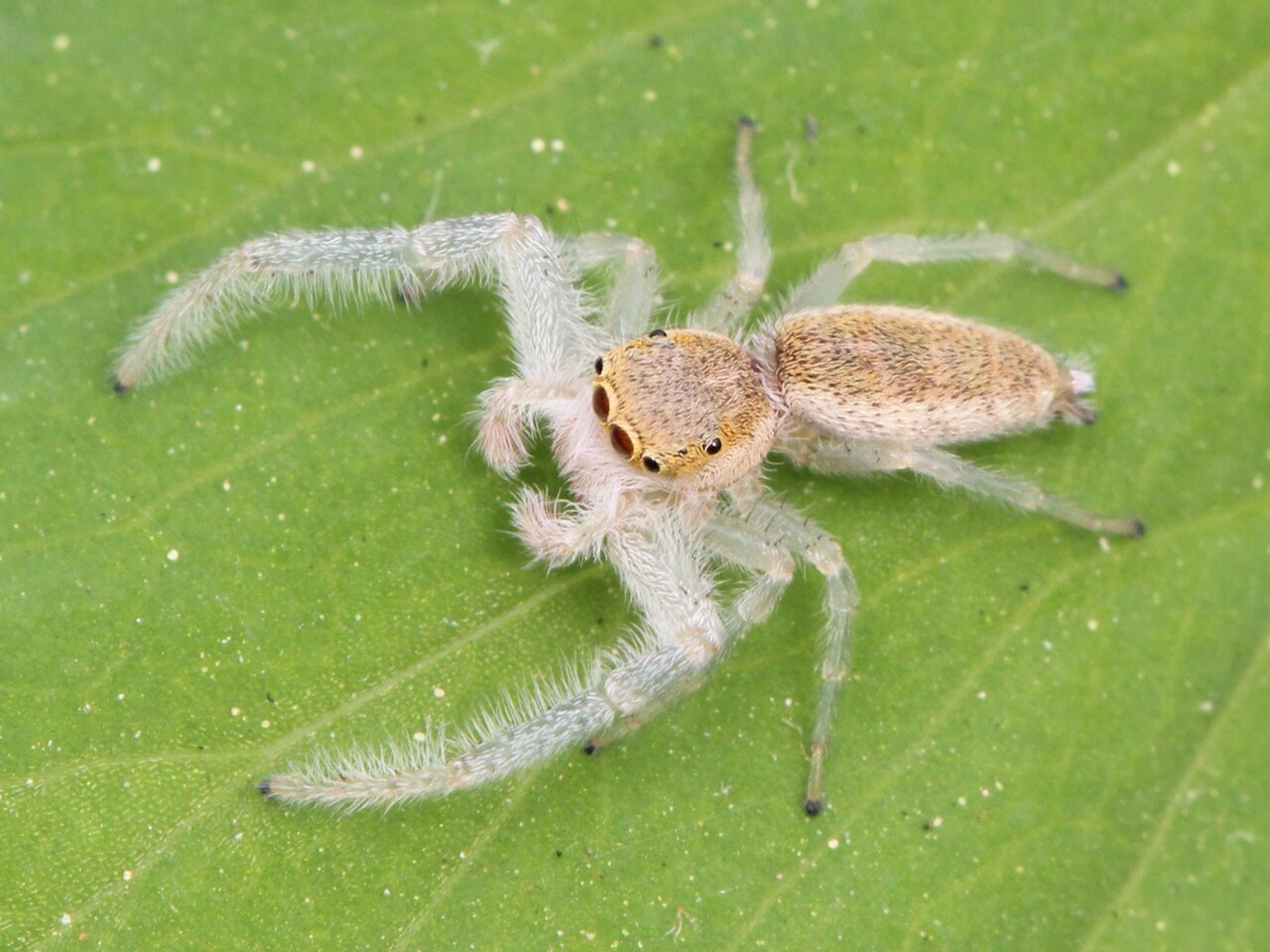
Scientific name: Hentzia mitrata.
Common name: white-jawed jumping spider.
White jawed jumping spiders can grow to around 3mm in body length and are almost invisible until they move.
Males have a bright red crown on their heads and their bodies are copper in color.
hey tend to be wandering hunters, which is why they often find their way into homes, cars, and other structures.
Their webs are not for capturing prey, but rather a place to molt and lay their eggs.
They are very curious little spiders that will happily jump from finger to finger if they feel safe.
32. Rabid Wolf Spider

Scientific name: Rabidosa rabida.
Common name: rabid wolf spider.
Rabid wolf spiders are fast-moving and erratic spiders, which is how they go their names.
They do not have or carry the rabies virus and they are harmless to humans.
They are aggressive and will appear to challenge you if you get too close, they will also bite if they are backed into a corner. You can handle one of these spiders without problems, as long as the handler knows what they are doing.
Bites are painful and are not medically significant, healing perfectly well on their own.
They are light brown in color with two thick brown lines on the sides of their heads. They have a brown central line on the abdomen with two thin brown lines on the sides of their body.
33. Dimorphic Jumping Spider

Scientific name: Maevia inclemens.
Common name: Dimorphic Jumping Spider.
The dimorphic jumping spider means two forms and they can be black with yellow legs or tan with red markings on the abdomen, they look completely different with females looking the same as the male but paler in color. Their bodies have short hairs.
They are fast and can jump great distances which helps them ambush prey and escape predators. They are small and fast, but they are not aggressive and are not inclined to bite humans.
34. Goldenrod Crab Spider

Scientific name: Misumena vatia.
Common name: goldenrod crab spider, flower (crab) spider.
The goldenrob crab spider is a spider that is able to use camouflage as a defense against predators. They will bite in order to protect themselves.
Their color can change over a course of a few days, helping them blend with their environment.
These spiders sit in the center of flowers, usually the Goldenrob flowers, and wait for a butterfly or bee to come by.
Males are smaller than the female with dark coloration, black front legs, and pale green back legs.
They have a white to cream abdomen with two dark red lines that run down the center. Juveniles tend to be light green in color, while females tend to be yellow or white. Females may or may not have spots, stripes, and red bands.
35. Broad-Faced Sac Spider

Scientific name: Trachelas tranquillus.
Common name: broad-faced sac spider.
The broad-faced sac spider is native to the eastern United States and is an outdoor spider, which may make its way into homes during the fall.
They are a solid dark brown to red color with a tan to gray abdomen. Their legs are tan, brown, or even red with the front being darker than the back.
Females grow to around 1cm in body length and 1.6cm in total length, including the legs.
They will bite if they feel threatened, which gives instant pain, similar to a bee sting. The bite is not considered medically significant unless you have an allergic reaction, which includes the swelling of the face and throat, along with trouble breathing.
36. Peppered Jumping Spider

Scientific name: Pelegrina galathea.
Common name: peppered jumping spider.
The peppered jumping spider has a stout body, rectangular thorax, short legs, and excellent jumping capabilities.
They have eight eyes, providing them with a full 360-degree angle.
Females are larger than the males and are grey with dark and light spots, while males are bronze brown with white patterns on the abdomen.
They are usually found in fields and prairies and agricultural crops where they are excellent at controlling pests.
37. Bowl-and-doily Spider

Scientific name: Frontinella pyramitela.
Common name: Bowl-and-doily spider.
Bowl and doily spiders are small spiders with large, shiny abdomens. The abdomen is usually dark brown to black with thick white vertical lines that look like inverted commas on the sides. The white turns to yellow at the base of the abdomen.
Females reach 4mm in body size with the males being slightly smaller.
38. Six-spotted Orbweaver

Scientific name: Araniella displicata.
Common name: sixspotted orbweaver.
The six spotted orbweaver is from the orb-weaver family Araneidae and is commonly found throughout the United States, Europe, Japan, China, and Korea.
These small spiders spin orb-shaped webs which are used to trap prey.
39. Banded Fishing Spider

Scientific name: Dolomedes vittatus.
Common name: Banded Fishing Spider.
The banded fishing spider is a large, brown, fast, and hairy spider that will flee when approached rather than being aggressive.
Females are large, which can make her look dangerous, while the males are considerably smaller.
They are always found near water where they hunt on aquatic insects. They are often seen floating on the water with their legs outstretched in all directions. They will often make a home in a covered boat in a boatshed.
40. Arabesque Orbweaver
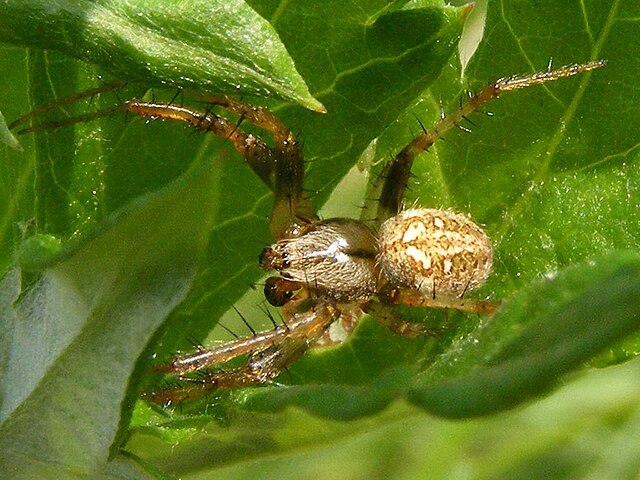
Scientific name: Neoscona arabesca.
Common name: arabesque orbweaver.
The Arabesque orbweaver comes in a variety of colors with some brown and other orange, others may be all black or grey.
Females have a wider and more rounded abdomen, while males appear slender.
They have a number of short lines and dashes which go on the center of the abdomen. They have thick black commas on their sides.
They create circular webs between bushes and near branches and handrails. They do not tend to spin their webs near high foot traffic.
They are not aggressive and will usually run and hide if approached.
41. Six-spotted Fishing Spider
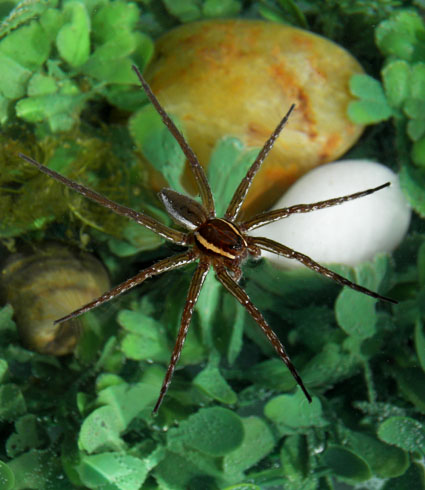
Scientific name: Dolomedes triton.
Common name: six-spotted fishing spider, dock spider.
This fishing spider is often found near boat docks and lakeside vegetation.
They look similar to a wolf spider with a large and boldly marked body.
They have eight equal-sized eyes and are brown to grey in color with light spots on their brown abdomens.
Females grow to around 2.6cm, with males being smaller at around 1.3cm.
42. Putnam’s Jumping Spider

Scientific name: Phidippus putnami.
Common name: Putnam’s Jumping Spider.
The Putnam’s jumping spider belongs to the Saliticidae family and is able to jump up to five times its body length.
They are hairy ambush predators and will spin a retreat for themselves, but do not use the web to trap prey.
They are active hunters and will jump towards their prey while shooting out a single silk thread, which prevents the insect from escaping.
They live in a variety of habitats from gardens and parking lots to forests and open fields. It’s not uncommon for them to wander into a home and are not considered dangerous.
43. Thin-spined Jumping Spider

Scientific name: Tutelina elegans.
Common name: Thin-spined Jumping Spider.
The thin-spined jumping spider is a small spider that is found in the United States.
Males grow to around 5mm, excluding their legs with a body that is green with some white hairs.
They have a plate covering the cephalothorax which is brown to red in color.
They have eight eyes in four pairs arranged in three rows. They have short legs, which are adapted for jumping with their front legs being the longest.
Females are larger than the male and can grow up to 6mm with a leg span of 9mm.
They are darker than the male with a larger abdomen with a white band around the base of the carapace.
44. Black-palped Jumping Spider

Scientific name: Pseudeuophrys erratica.
Common name: Black-palped Jumping Spider.
Black palped jumping spiders can grow to 5mm for females and 4mm for males.
They are commonly found in spring and summer, though there are some females still observed in the fall.
These spiders are widely spread throughout the world and have been reported in numerous states, including Pennsylvania.
45. Grey Cross Spider

Scientific name: Larinioides sclopetarius.
Common name: bridge spider, gray cross spider.
The grey cross spider female is considerably heavier than the male, weighing up to 60mg, while males can weigh up to 38mg.
At the same time, the male tends to be larger in size than the female with males growing up to 7mm and females up to 6.25mm.
They have white hairs that create a silhouette for their heads with dark markings on their abdomens.
They do not tend to bite humans and can be found in large numbers. Their venom can feel anything from a mosquito bite to a bee sting.
46. Garden Ghost Spider
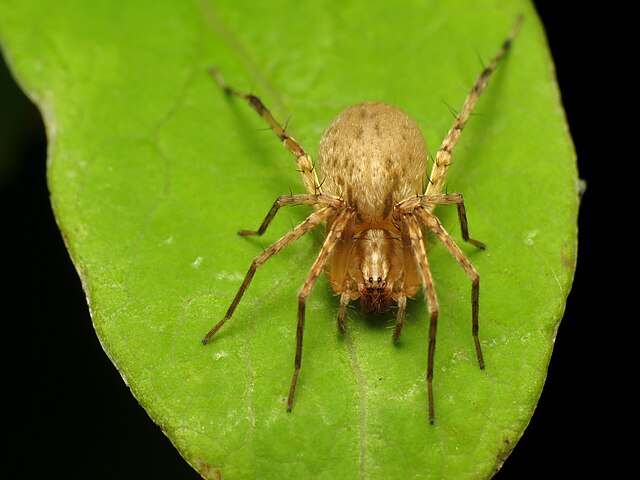
Scientific name: Hibana gracilis.
Common name: garden ghost spider.
The garden ghost spider is a member of the Anyphaenidae family and can be found in the United States and Canada.
The tips of their legs have claw tufts which allow them to climb vertical surfaces, they are nocturnal and very fast runners, which enables them to escape predators.
They are small to medium-sized spiders and very pale in color.
These active little spiders are often observed at night as they run across the ground searching for food.
47. White-banded Fishing Spider

Scientific name: Dolomedes albineus.
Common name: white-banded fishing spider.
White banded fishing spiders are members of the nursery web spiders and are indigenous to the United States.
Females can grow to 0.90 inches (2.3cm), while the males are slightly smaller, growing to around 0.70 inches (1.8cm) in length.
They vary in color from brown to moss green, with dark markings on their body and a white band below the eyes.
48. Northern Crab Spider

Scientific name: Mecaphesa asperata.
Common name: Northern crab spider.
Northern crab spiders are shy small spiders that hide in the petals of flowers waiting for insects to come and feed on the pollen.
They are able to camouflage themselves based on the flowers they are hunting in, though the change in color does take a few days.
They have over-sized front legs, which they use when capturing beetles, butterflies, and flies.
49. Sylvan Jumping Spider

Scientific name: Colonus sylvanus.
Common name: Sylvan Jumping Spider.
The Sylvan jumping spider is completely harmless to humans and is relatively curious.
They are found throughout the United States, though it is the male that is mostly observed.
You can handle them gently, though they will try and bite if you accidentally squeeze them too tightly.
They are a delight to allow to jump on your fingers as they explore your hand.
50. Common Hentz Jumping Spider

Scientific name: Hentzia palmarum.
Common name: common hentz jumper.
The Hentz jumping spider is a small spider that pounces on its prey rather than spinning an intricate web.
They are able to jump considerable distances for their size.
They are fast and are able to jump away from potential threats, including humans.
Their first pair of legs are dark reg with the rest being yellow. They have a red to brown coloration on the head which is bordered in white hair. They have dark bands crossing the abdomen.
They are usually seen on the ground outdoors, though they may make their way indoors looking for their next meal.
They are not harmful and would much rather jump away than bite a human.
51. Shamrock Orbweaver
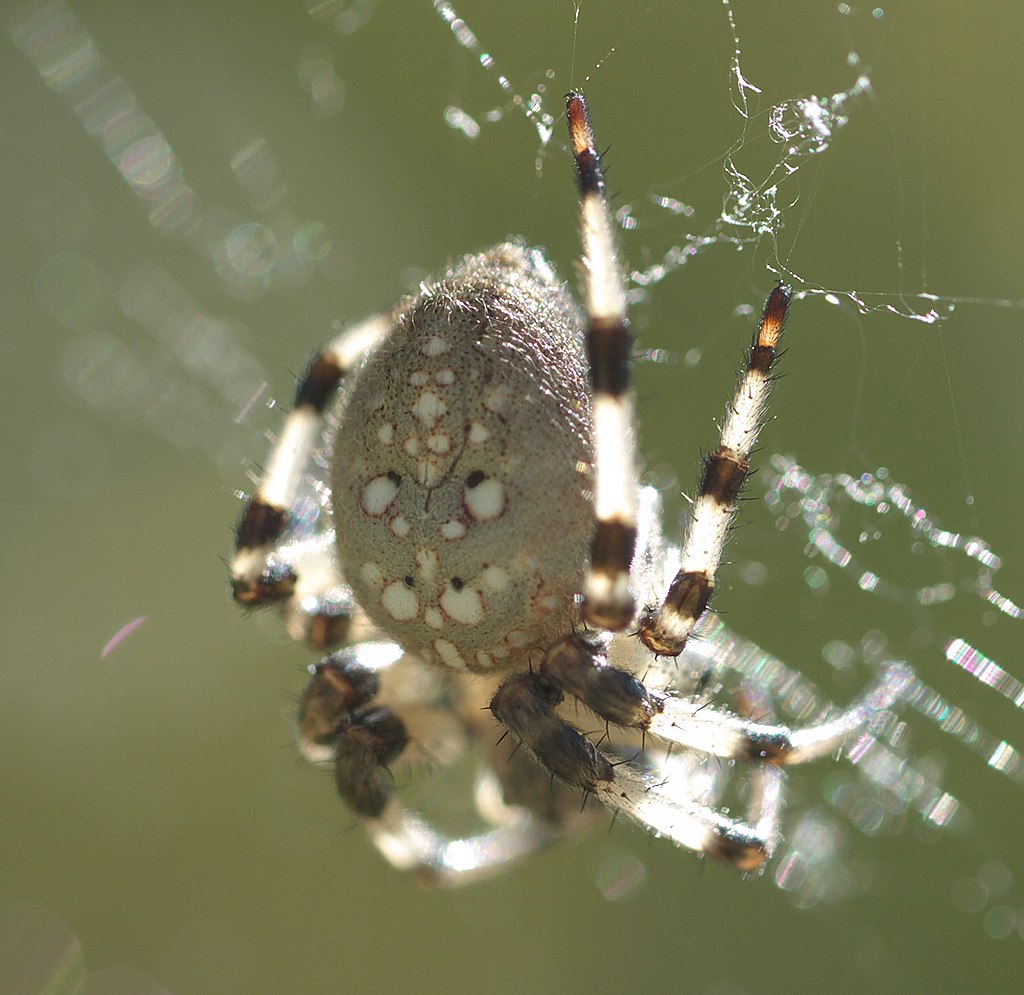
Scientific name: Araneus trifolium.
Common name: shamrock orbweaver.
The shamrock orbweaver is a black and white-legged spider that varies in color from yellow to red, purple, and white. Some have white patches on their abdomen.
They create new webs daily and sit upside down in wait for prey to get trapped.
They prefer tall grasses and shrubs in woodlands, near marshes, streams, and creeks. They are also found in gardens and parks.
52. False Black Widow

Scientific name: Steatoda grossa.
Common name: cupboard spider, dark comb-footed spider, brown house spider (in Australia), false widow, false black widow.
The false black widow is native to Europe with white abdominal markings, growing to around 1cm in body size.
Bites from these spiders are very rare and they are not dangerous to humans with their sting being the same as a wasp sting.
The females are larger than the females with a large black-brown abdomen, males have some cream abdominal markings.
They create a tangled web, which is a well-constructed tube, which they use for cover.
They are nocturnal and very seldom observed.
53. Grayish Jumping Spider

Scientific name: Phidippus princeps.
Common name: Grayish Jumping Spider.
The grayish jumping spider can be found in the eastern United States.
They have an outstanding vision and can jump considerable distances for their size, which they use to ambush prey and escape predators, including curious humans.
They are mostly observed in July and September and mostly females have been observed to date.
54. Hammer-jawed Jumping Spider
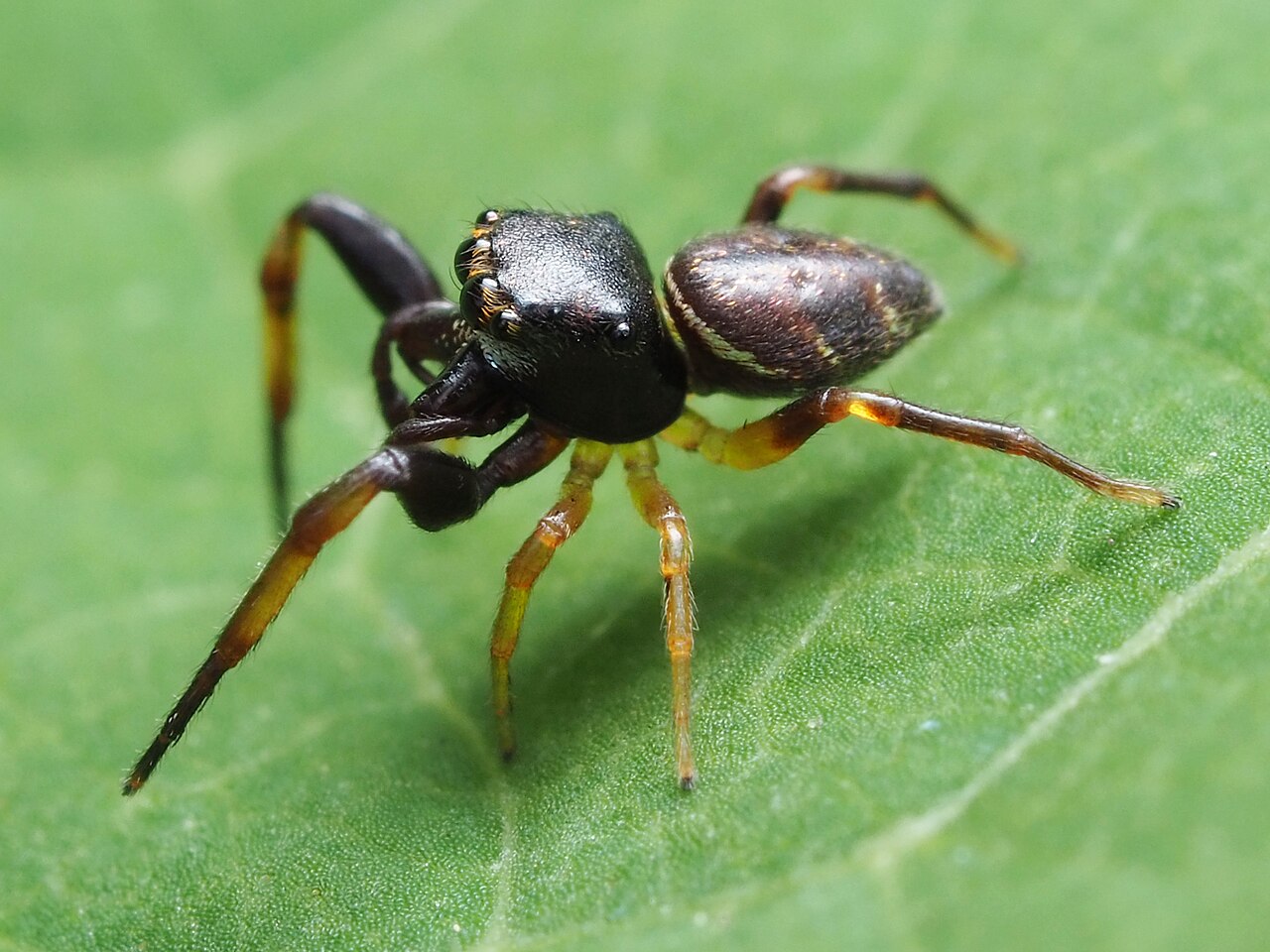
Scientific name: Zygoballus rufipes.
Common name: hammerjawed jumper.
The hammer jawed jumping spider can be found in the United States, Canada and Central America where females are larger than the male growing between 4.3mm and 6mm in body length.
They are harmless to humans and will not bite unless accidentally squeezed or stamped on.
55. White Micrathena

Scientific name: Micrathena mitrata.
Common name: White Micrathena.
The white micrathena has a white abdomen that bulges at the sides and comes to two sharp points at the back.
They have the appearance of being wrapped in a turban.
The abdomen has two black patches with white speckles along with some dark dashes on both sides.
The head is black to dark brown with pale legs that darken at the feet.
This is a small spider that spends most of its time in plants hunting prey.
56. Filmy Dome Spider

Scientific name: Neriene radiata.
Common name: filmy dome spider.
The filmy dome spider is a sheet-web spider that creates superfine silk dome-like sheets.
This is a nocturnal spider that is small in size, spending most of the day hidden in leaf litter.
They can vary in color and are often brown or black with white to yellow stripes on the abdomen. Some are black and white; some are brown and others are two toned.
Males are smaller than the female and have slender abdomens.
57. Ribbon Jumping Spider

Scientific name: Metacyrba taeniola.
Common name: Ribbon Jumping Spider.
The ribbon jumping spider belongs to the Salticidae family of jumping spiders with males grown to 6mm in body length and females being larger at around 7.2mm in body length.
They can easily be identified for their stout bodies, jumping capabilities, short legs, and rectangular thorax, along with their eight eyes, which give them full 360-degree vision.
58. Striped Lynx Spider

Scientific name: Oxyopes salticus.
Common name: Striped Lynx Spider.
Adult striped lynx spiders are a blend of brown, cream, and orange with females having stripes on the abdomen and carapace.
Females are larger than the males, growing to around 6mm with males growing to 5mm.
They have a diamond cardiac mark and are not considered a medical emergency should you be bitten.
Bites are painful, causing localized swelling and redness which will go away on their own within a couple of days.
59. Brilliant Jumping Spider

Scientific name: Phidippus clarus.
Common name: Brilliant Jumping Spider.
Brilliant jumping spiders also have excellent vision, believed to be 10 times that of a dragonfly.
They use these eyes to identify prey and rivals, along with finding a mate.
They can jump up to fifty times their body length using their powerful and short legs.
They ambush their prey and using their jumping distance and speed to escape predators.
60. Labyrinth Orbweaver

Scientific name: Metepeira labyrinthea.
Common name: labyrinth orbweaver.
The labyrinth orbweaver has its name from its tight web, which is made of concentric rings and circular mazes.
They use dried leaves to conceal themselves within the web as they wait for prey to get snagged.
They have a distinctive abdomen pattern, which is a jagged-edged triangle in black, pointing towards the back on a brown base color.
There are two sets of white curls and a stripe of light hairs that run down the black triangles center.
Their legs are orange to brown with wide black and white banding.
Further Reading: